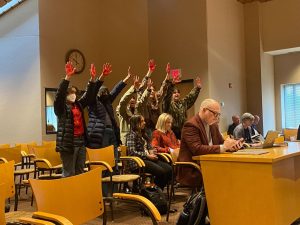In their report-heavy December meeting, the Board of Regents heard updates on MPact 2025 and a report from the Faculty Consultative Committee (FCC).
The Board also reviewed the effectiveness of on-campus public safety during the fall semester and was interrupted by a Students for a Democratic Society (SDS) protest.
At the end of the public session, the regents convened for a non-public meeting to further discuss legal strategies for the eight ongoing lawsuits against the University due to the data breach in July.
Public safety after the Dinkytown shooting
The Board was presented with an update on public safety on campus during the fall semester, given by Myron Frans, senior vice president for finance and operations.
Newly implemented public safety initiatives on campus, like the turnstiles in Pioneer Hall, have proven successful so far, Frans said. Housing and Residential Life will also begin adding turnstiles elsewhere across campus, starting with Middlebrook Hall on the West Bank and 17th Avenue Residence Hall on the East Bank.
Regent Penny Wheeler said she also heard positive student responses about safety on campus through the blue light and turnstile systems and an increased UMPD presence.
According to Frans, these investments have also seen a positive return in off-campus safety. He said statistics show crime in the Marcy-Holmes area has slowly been declining.
Frans said the next steps are to dedicate more time to making more specific crisis response and emergency preparedness plans. He said having existing plans in place in the event of another incident like the Dinkytown shooting the weekend of Dec. 2 can save lives.
Interim President Jeff Ettinger agreed that even though public safety on- and off-campus has greatly improved over the fall semester, the shooting in Dinkytown underscored how the University’s work in ensuring an even safer campus is far from over.
“There’s always more to do, and I will not waver on safety being a top priority,” Ettinger said.

An interruption by SDS
The meeting was interrupted almost immediately by an SDS protest denouncing Israel’s attacks on Palestine. During Ettinger’s report, the protestors raised painted-red hands and chanted, “Board of Regents, you can’t hide. We charge you with genocide.”
Chair Janie Mayeron called a Board recess during the interruption.
The protest only lasted around three minutes. As the protestors marched out of the conference room, their chants changed to, “Not another penny, not another dollar, no more money for Israel’s slaughter.”
An update on MPact 2025
Ettinger and Rachel Croson, executive vice president and provost, gave the Board a presentation on the University’s five-point systemwide strategic plan MPact 2025 showcasing how close the University is to completing its promised goals under the program.
Out of the systemwide 30 goals outlined in MPact 2025, two have been fully completed and 24 are nearing completion. Ettinger said he was grateful to see this active strategic plan when he stepped into his role and is excited to help see it to fruition.
Croson said MPact 2025 has helped serve Minnesotans and raised the University to a new level of accomplishment.
“One thing we should think about in receiving these reports is what’s next,” Regent Kodi Verhalen said. “Especially because this [plan extends to] 2025, and we’re already less than 30 days to 2024.”
Report from the Faculty Consultative Committee
Mark Bee, chair of the Faculty Consultative Committee (FCC), delivered a report to the regents that sounded an “alarm bell” on items the regents need to consider.
According to the FCC Report on Faculty Compensation, the University has the lowest faculty salary of the top 10 public universities in the country. The report shows UMN faculty salary averaging around 20% below peers.
Bee said the University’s willingness to offer an increased salary is key to helping faculty feel valued and retaining a strong workforce. He recounted a story where his wife, a faculty member at the University, was offered a similar position at Ohio State University.
“She went to her department and sought what we thought was a reasonable retention package,” Bee said. “Their response was: go to Ohio State.”
Ettinger thanked the FCC for compiling their report. He said it identifies some true problems the University needs to address.
Bee said these alarms are being sounded at a “pivotal moment,” when the Board is preparing to select the next University President.
“There is some hope that our next president will put us on a new strategic path that genuinely and successfully pursues excellence,” Bee said. “I think I speak for many faculty and staff, and I hope students too, in saying that the alternative is not something any of us are very interested in.”
